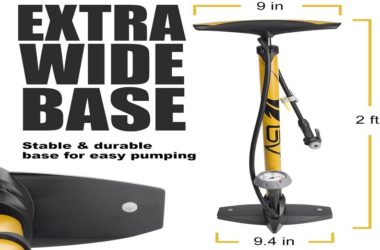Some old stuff can endure the test of time, such as a good bicycle, additional things cannot or should not. A bicycle helmet should not be applied for a lifetime. Maybe you have asked the question, “When do bike helmets expire?” or “What is the life extent of a bike helmet?” I questioned the same thing and searched the web to put this article together. In this article, we at BestComfortBike will answer the question when do bike helmets expire? Equip to understand the details about the life of a bike helmet.
When do bike helmets expire? The fast and simple answer is that a bike helmet does not have an end date, but should be renewed every 5 years. The Snell Memorial Foundation is an organization that has been experimenting and establishing safety standards for all kinds of guarding the gear. They established the bar high when it becomes to security, and they are the ones who came up with the 5-year number. Also, a bike helmet should be renewed after a bike crash or if you find any holes or cracks.
Table of Contents
Why pick 5 years?
The Snell Foundation grew up with this number based on its decisions and those of helmet makers. They occurred to this number based on three common factors. Factor #1 is that any of the materials utilized to make the helmet generally start to deteriorate over time. Factor #2 is that over 5 years a helmet will come into connection with sunblock, hair oils, cleaners, body fluids, and other cosmetics that attach to the wear and damage of a helmet. Factor #3 is that the industry is continually updating helmets in design, materials, and standards. A helmet from this year is more liable to be more trustworthy than a never worn helmet from five years ago.
These are the circumstances that they thought when they come up with their 5-year recommendation. The word ‘recommendation’ is the dictionary that they applied. Take that though you need it. The Snell is a well-known non-profit corporation that was identified after a guy who died in a racing accident when his helmet failed to save him. It should be said that their aim is not cash, but your protection. You can read Snell’s reasoning for the 5 years here.
Does this indicate every helmet will remain for 5 years? Not. Here are some things you should think about when deciding whether it is time to replace your helmet or not.
Guide About When Do Bike Helmets Expire

1. Fits the Standard
The helmets necessitate meeting specific security standards. The companies that established the security standards to see at how well a helmet stays on, the coverage of security, how impact energy is distributed, and more. When a helmet has met these standards through examination they will get a stamp from either the Snell Memorial Foundation, the Consumer Product Safety Commission, or the American Society for Testing and Materials. If your bike helmet has not met the standards of one of these organizations, you should renew it.
2. If you hit renew it
Every safety standards organization and helmet firm agree: if you crash while wearing a helmet you necessitate to renew it. The Bike helmets are not intended to be utilized after they have been involved in a crash. They are a one-time usage thing.
The helmets are composed of foam stuff that concentrates upon impact. When you crash and hit your head on the asphalt the foam will be pressed to serve as a cushion to defend you. The compressed foam would not do the role as well as when it is non-compressed so it is time to get a new helmet. Even if your helmet seems to be ok after a crash, the foam underneath the shell has probably absorbed the impact and you just can not see it.
I caught a nasty fall years ago that ended with a cracked collarbone, but thankfully my head was protected thanks to my helmet.
All this to say…if you hit on your helmet it is time to get a replacement.
3. Helmet Examination
Checking your helmet is usually a more reliable way to determine if it should be renewed. Examine the outer shell for breaks or splits, then press on it to view if the shell pops back into place. If there are holes or the shell does not spring back, replace the helmet. A helmet additionally should be renewed if the shell has evaporated from UV exposure, as the plastic may have faded. Next, check the foam liner for any cracks or scratches and the bands and buckles for any worn or tattered areas.
4. An Exact Termination Date?
Drink a glass of milk after it is terminated and you know it is evil by the taste and smell. It is not truly equal with a bike helmet, because it can proceed to see and observe good sufficient to preserve your dome. The Snell 5 year mark is a certificate. The helmet makers give their termination timeline for their helmets. I have viewed some say that it is time for a new helmet as soon as 3 years and others state they are good for 8. I would be doubtful to purchase a helmet when the producer is declaring that it will just be good for 3 years. To me, that looks like a cash grab to make clients buying a new helmet as soon as possible. Examine what the bike helmet maker says about your particular helmet and life span.
5. How precisely do helmets wear out?
Interestingly satisfactorily the foam that helmets are built would not degrade any time soon. A research done by MEA Forensic discovered that the foam liners from helmets will maintain their show for many years. Therefore if the foam would not degrade how does a helmet wear out? The breakdown of a helmet occurs when the outer shell deteriorates from UV light. The UV light can cause shell brittle. One of the goals of the shell is to maintain the foam preserve of its building. If the shell is weak than a high influence crash will compromise the architectural sincerity of the foam. The foam is less likely to take proper shape and can break upon impact.
6. Have an eye on it
It is suggested that you watch over your helmet regularly. Examine the foam for tears, splits, and breaks. Be sure that the chinstrap and buckles are not ripped and are operating well. You should additionally examine the shell to be sure it is not sunk from UV light. If you see any problems with the helmet than it is time to get yourself a new one.
What about vintage helmets?

Do you have a vintage helmet that you admire to wear while cycling nearby? More traditional helmets offer great collectables, but should not be trusted to hold you secure. The Bike helmets built before the 1990s should not be wasted. The elements that were practiced do not meet protection standards and will not protect in a bike crash. More modern helmets have a hard shell to help prevent the foam together and additionally enable your head to slide along the ground in case of a crash. More traditional helmets either do not have the hard shell or have a thin foam liner. They may be fun cycling piece of memorabilia, but do not trust your well being by wearing one while you ride.
Conclusion
Cycling is not the most reliable of activities, and a bicycle driver should consider steps to stay secure while going to work. The facts are that in 2016 there were 835 bicyclists killed in crashes with motor vehicles in the US. Of this number 51 percent of the cyclists were not carrying helmets, 16 percent wore helmets, and 33 percent were not registered. It is clear to see that a helmet can protect your life in an unfortunate event. Why take the chance? Wear a helmet to continue riding for several years, and be sure that it satisfies the guidelines given in this article so that it will be useful if necessary.




